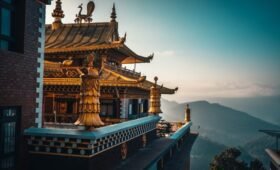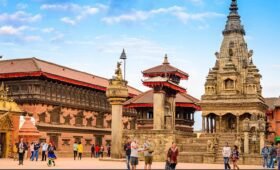History of Nepal
The earliest rulers of the Kathmandu Valley are believed to have been the Gopalas and Mahishapalas, who kept their capital in Matatirtha, in the southwest. From the 7th or 8th century B.C. the Kirantis, led by the famous King Yalumber, ruled the valley.
Around 300 A.D. the Lichhavis arrived from northern India and overthrew the Kirantis. A remaining legacy of this time is the Changu Narayan Temple near Bhaktapur, a UNESCO World Heritage Site that was completed in the 5th century A.D.. In the early 7th century, the first Thakuri King Amshuvarma took over the throne from his father-in-law, a Lichhavi. King Amshuvarma married off his daughter Bhrikuti to the famous Tibetan King Songtsen Gampo, thus establishing a good relationship and close ties with Tibet. This era was one in which art and architecture flourished in the valley, but the real Golden Age of creativity arrived in 1200 A.D. with the Mallas.
Throughout a 550-year rule, the Mallas built hundreds of temples and splendid palaces with picturesque courtyards. It was also during their rule that society and cities in Nepal became well organised, religious festivals were introduced, and literature, music and art were encouraged.
Following the death of Yaksha Malla, the valley was divided into three kingdoms: Kathmandu (Kantipur), Bhaktapur (Bhadgaon) and Patan (Lalitpur). Around this time, the Nepal that we know today was divided into about 46 independent principalities. One among these was the kingdom of Gorkha with a Shah ruler.
During the 17th and 18th centuries, Gorkha continued a slow expansion, conquering various states and forging alliances with others. Finally, an ambitious Gorkha King named Prithvi Narayan Shah embarked on a mission that led to the defeat of all the kingdoms in the valley (including Kirtipur which was an independent state) by 1769.
Instead of annexing the newly acquired states to his kingdom of Gorkha, Prithvi Narayan decided to move his capital to Kathmandu, establishing the Shah dynasty which ruled unified Nepal from 1769 to 2008. Recognizing the threat of the British in India, European missionaries were dismissed from the country for more than a century, and Nepal entered a time of isolation.
During the mid-19th century, Jung Bahadur Rana became Nepals first Prime Minister to wield absolute power, relegating the Shah Kings to mere figureheads. Jung Bahadur Rana started a hereditary reign of the Rana Prime Ministers that lasted for 104 years. The Ranas were overthrown in a democracy movement of the early 1950s with support from the monarch of Nepal, King Tribhuvan. Soon after the overthrow of the Ranas, King Tribhuvan was reinstated as the Head of the State.
In early 1959, Tribhuvan’s son King Mahendra issued a new constitution, and the first democratic elections for a national parliament were held. The Nepali Congress Party was victorious and their leader, Bishweshwar Prasad Koirala formed a government and served as Prime Minister. But by 1960, King Mahendra had changed his mind and dissolved the parliament, dismissing the first democratic government.
For many years there was struggle, and political parties were banned, until they finally mustered enough courage to start a Peoples Movement in 1990. Paving the way for democracy, the then-King Birendra accepted constitutional reforms and established a multiparty parliament with King as the Head of State and an executive Prime Minister. In May 1991, Nepal held its first parliamentary elections. But in February 1996, the Maoist parties declared a Peoples War against the monarchy and elected government.
Then on June 1st 2001, a horrific tragedy wiped out the entire royal family including King Birendra and Queen Aishwarya along with many of their closest relatives. Only King Birendra’s brother, Gyanendra, and his family survived, so he was crowned king. King Gyanendra abided by the elected government for some time and then dismissed the elected Parliament to wield absolute power.
In April 2006, another joint Peoples Movement was launched by the democratic parties, focusing most energy in Kathmandu which led to a 19-day curfew. Eventually, King Gyanendra relinquished his power and reinstated the Parliament. On November 21, 2006, Prime Minister Girija Prasad Koirala and Maoist chairman Prachanda signed the Comprehensive Peace Agreement (CPA), committing to democracy and peace for the progress of the country and people. A Constituent Assembly election was held on April 10, 2008. On May 28, 2008, the newly elected Constituent Assembly declared Nepal a Federal Democratic Republic, abolishing the 240 year-old monarchy. Nepal today has a President as Head of State and a Prime Minister heading the Government.



